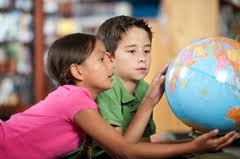In order for technology to impact
student learning, it must be used to deepen student’s engagement and
understanding in an authentic manner.
Before getting too invested in a technology tool, focus on the learning
objective. There are so many resources
available nowadays and being able to sort through them all can be
overwhelming. Take baby steps and start
with one tool and build upon that once you are ready. On the other end of the spectrum, don’t be
afraid to take risks and let your students take charge and become your
classroom “Tech Champion.”
One of my favorite online resources
is Interactive Sites for Education. This site works well with all interactive
white boards and will get your students engaged and interacting with the
content through educational games and simulations. This site works well in a variety of
settings, from whole-class, small group, computer lab, or at home for student
practice. This site organizes their
resources by content area and then by topic.
They are continuously adding new content, so be sure to check back
regularly for updates.
Another of my favorite online
resources is StoryBots. This site is
100% free for teachers. There are
learning videos that are engaging and fun for example: Letters, Numbers,
Colors, Outer Space, Body Songs, Great Innovators, etc. Did you know that a student’s ability to
retain knowledge increases 60% when the subject matter is delivered with video? With your free teacher account, you can
upload pictures of your students and create “Starring You” books and videos to
spotlight a student. Many upper
elementary classrooms use picture books to introduce/review concepts, and the
list of titles available in the “Starring You” books continue to grow, for
example: Shape-Land, Weather Sounds, The Pirate’s Tale, etc.
Another great resource is my
compilation of Webcams Symbaloo webpage. I have compiled animal webcams from around
the world for students to venture out of the classroom and view animals in
their natural habitat. One of my
favorites is Explore.org
because they do the work for you and update their main page with animals that
are active and also integrate information about the animals, location,
date/time, and many also include sound.
What an amazing way to allow students to “visit” another part of the
world and make observations, predictions, collect data all while never really
leaving the classroom.
In order to drive instruction,
teachers often use formative assessments to get a read on students
understanding of concepts. There are
many online resources that are excellent formative assessments, here are a few
of my favorites:
- Plickers – No need for 1:1 devices, students use reusable cards to show their understanding, while the teacher scans the room with his/her device to get a quick snap shot of students’ understanding of concepts.
- Kahoot – Teachers create a fun learning game, ‘kahoots,’ made from a series of multiple choice questions. Students then use devices in small groups, 1:1, or in a computer lab setting where they answer on their own devices and then overall results are shared to promote discussion and pedagogical impact.
- GoFormative – Teachers create an assignment and assign it to students and then can receive live results and give feedback. GoFormative goes beyong multiple choice as students can type, show their work with drawings, or submit images.
Did you know that giving feedback
has the highest impact on student learning?
Technology
in education continues to grow and it is our responsibility as educators to
provide our students with the opportunities to create, collaborate, challenge,
and enhance their learning. The best
thing about integrating online tools is that they can be molded to fit each
teacher’s specific needs in order to ultimately meet the needs of the students
in the classroom. So be a risk taker and
start integrating!
Online Resources:
Jenn Kapp is originally from Michigan, but has lived in NC for
over 20 years and considers herself to be a North Carolinian. She is married to a
Veteran U.S. Marine and they have two children. She began teaching in Wake
County for seven years, then we moved down to Jacksonville where she has taught for
eight years. She attended Appalachian State University to earn her Bachelors
of Science in Elementary Education and continued on to earn a Masters of Education in
Instructional Technology at East Carolina University in the spring of 2014.
Go Pirates!!! She enjoys working with two elementary schools assisting
with integrating fun and exciting technology tools into the already fantastic
teaching and learning that is happening in Onslow County. She believes that the possibilities with technology integration are endless!





















